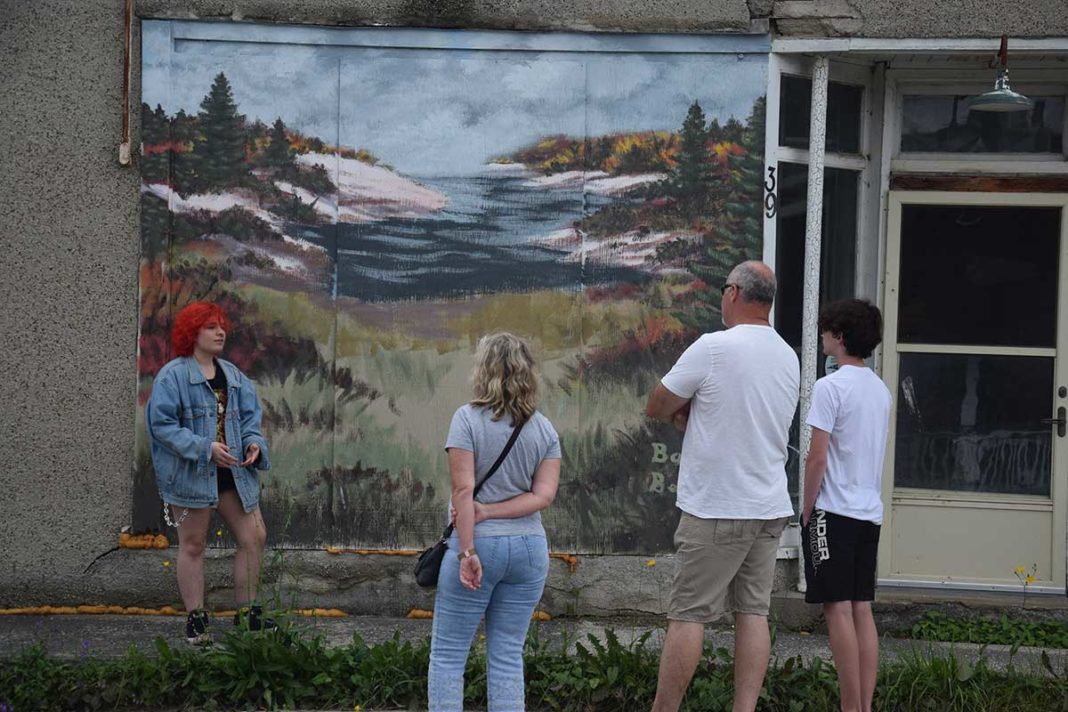MANITOWANING – As the Island’s oldest non-Native settlement, Manitowaning holds many fascinating historical moments close to its breast. Debajehmujig Storytellers has set about creating an ongoing series of historical guided tours of the town’s main highlights, with a narrative as seen through an Indigenous lens.
Summer student Samuel Howson prepared for his main gig by delving into a number of books and articles about the history of Manitowaning and he found, like much of the history of time and place, not everyone agrees on all points. Nonetheless, the student has woven a fascinating tapestry that is delivered in an engaging and animated hourlong tour that takes participants on an exploration well worth spending an hour or so on a summer afternoon.
Samuel begins the tour with a brief history of Debajehmujig itself, one of this nation’s first Indigenous theatre troupes that remains the only one of its kind based on a First Nation (the head office is in Wiikwemkoong). Founded by acclaimed Indigenous artist, actor, filmmaker and current chancellor of Brock University, Shirley Cheechoo, it was initially set up in M’Chigeeng First Nation, where Ms. Cheechoo continues to live and has since also founded Weengushk Film Institute—with a similar goal of telling Indigenous stories from an Indigenous perspective by Indigenous storytellers.
A series of large mural paintings adorn the front façade of the Debajehmujig Creation Centre located in the renovated historic Mastin building in downtown Manitowaning. The artworks are the creations of artist and former Debajehmujig artist in residence, Barry Beaver. Mr. Beaver is a Cree artist from Wabasca First Nation whose artworks embody many of the core values of the theatre group. From the battle of Thunderbird and the lake monster embellished on the garage doors that provide access to the main creation stage, to the panels adorning the neighbouring residence of Jeannette Corbiere Lavell, the artwork melds Mr. Beaver’s western roots with those of Eastern Ontario.
Moving onto areas near the Manitowaning waterfront, Samuel takes participants back to 1836 and the community’s beginnings as the location of the “Manitowaning Experiment,” a socializing project undertaken by the government of what was then Upper Canada, supported by the Anglican church. The Manitowaning Experiment sought to invent a model community, complete with all of the trades common to settlements further south, and infused with the great civilizing values of the empire of Great Britain. Replete with a cooper’s shop, blacksmithy, shoemaker, carpentery and a host of other trades, the concept was that the First Nations people would learn and, of course, adopt the “superior” trappings of European modernity. The plan was to create a base for the Island to become an “Indian” nation, with Indigenous peoples from across Upper Canada and beyond enticed to settle on its shores.
The socialization experiment included some good old-fashioned Christian evangelism (Anglican). St. Paul’s Anglican Church, which stands to this day and is featured on the tour, began construction in 1845—making it the oldest church in Northern Ontario.
From the annual treaty gift-giving that took place on the shores of Manitowaning Bay (immortalized in a painting by Paul Kane) to the Assiginack Museum, a former jailhouse that did duty in a number of incarnations, Samuel deftly guides his charges along the route and back to the rear of the Debajehmujig building, where the more spiritual aspects of the history of Mnidoo Mnising are shared.
Inside the building, the students studying improv theatre techniques are themselves guided by Debaj’s veteran staff. When not guiding tour groups, Samuel is also one of the students taking part in the training.
The tours take roughly an hour and follow an accessible route that should prove little barrier to those with physical challenges and the tour guide is accommodating.
The free guided tours run Monday to Friday, with sessions at 11 am and 2:30 pm. To book a tour call 705-859-1820 or email storytellers@debaj.ca.





